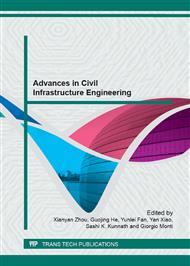p.577
p.581
p.587
p.593
p.598
p.602
p.608
p.615
p.619
Study of the Effect of Shear Rates on Residual Shear of Landslide Soil
Abstract:
The residual strength is one of the most important strength parameters to evaluate the stability of a reactivated landslide slope, but the relation between residual strength gained by using ring shear tests and shear speed still remains unclear. In order to clarify the relationship between them, the variation in residual friction coefficient of slip surface soils with shearing rates were calculated and discussed in this paper by means of an undrained ring shear apparatus on Miaowan sample of China-Loess Plateau , predominantly consists of silty-sandy(81.3%), and Kamenose sample of Japan, predominantly consists of clay(73.2%) in texture .The residual friction coefficient was observed to be lower for higher shear rates in Kamenose sample;while the variation of its shear behaviour at different shear rates is fluctuant in Miaowan sample. This change in pore water pressures and soil texture could be thought as the rate effect mechanism of residual shear strength.
Info:
Periodical:
Pages:
598-601
Citation:
Online since:
January 2013
Authors:
Price:
Сopyright:
© 2013 Trans Tech Publications Ltd. All Rights Reserved
Share:
Citation:


